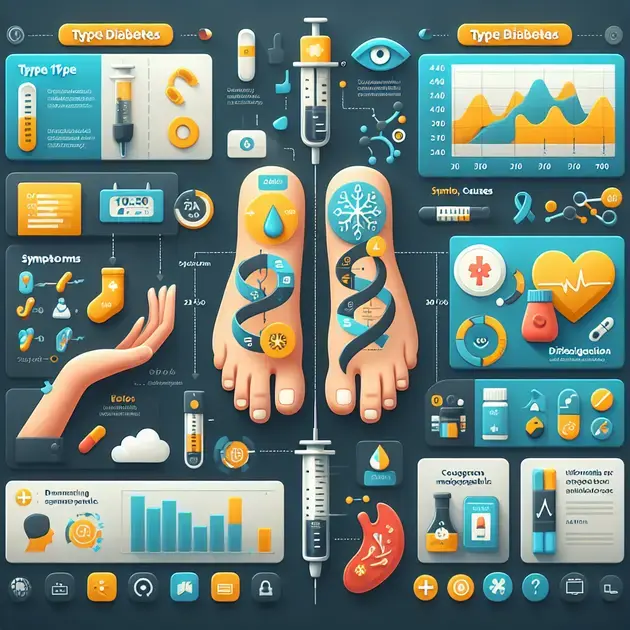Understanding the differences between type 1 and type 2 diabetes is crucial for anyone affected by these conditions. While both types disrupt blood sugar regulation, their causes, management, and implications vary significantly. This knowledge not only empowers patients but also aids families and friends in supporting their loved ones effectively.
Dive into our comprehensive guide as we dissect the key distinctions, from risk factors to treatment options, equipping you with essential insights to navigate this complex landscape of diabetes care.

Understanding the General Differences Between Type 1 and Type 2 Diabetes
Diabetes is a chronic condition that affects how your body processes glucose, a vital source of energy. The two main types of diabetes are Type 1 and Type 2, each with distinct characteristics. Understanding these differences is crucial for effective management and treatment. Type 1 diabetes is an autoimmune condition where the body’s immune system attacks insulin-producing beta cells in the pancreas. It usually manifests in childhood or adolescence, leading to a complete insulin deficiency.
On the other hand, Type 2 diabetes is more common and often develops in adults, although it increasingly affects younger individuals due to lifestyle factors. In Type 2 diabetes, the body becomes resistant to insulin, or the pancreas does not produce enough insulin. This type is often associated with lifestyle factors such as obesity, inactivity, and poor diet.
One of the biggest distinctions lies in their underlying causes. Type 1 is primarily genetic and autoimmune, while Type 2 is heavily influenced by lifestyle choices. For a thorough understanding, individuals can explore resources available on apps like MySugr, which provide detailed information on types of diabetes and their management.
Diagnosis also differs significantly between the two types. Type 1 diabetes often requires immediate insulin therapy after diagnosis, whereas those with Type 2 may initially manage their blood glucose levels through lifestyle changes. Over time, many Type 2 patients may require insulin or other medications as their condition progresses.
Ultimately, recognizing these differences is crucial for those affected by diabetes. Understanding what type of diabetes one has allows for the development of a personalized treatment plan and empowers individuals to take control of their health. Resources like Diabetes.co.uk can offer insights and tailored advice.
Common Symptoms of Type 1 and Type 2 Diabetes You Should Know
Recognizing the symptoms of diabetes is critical for early detection and management. Both Type 1 and Type 2 diabetes share several common symptoms, but there are also key differences that can help differentiate between the two. Common symptoms include increased thirst, frequent urination, extreme hunger, fatigue, and blurred vision.
One significant difference is the rapid onset of symptoms in Type 1 diabetes. Individuals may notice symptoms developing in a matter of days or weeks. This urgency in symptom onset often leads to a quicker diagnosis. In contrast, Type 2 diabetes symptoms may develop gradually over months or even years, which can delay diagnosis and treatment.
To monitor and track symptoms, users can find useful tools on apps such as Glucose Buddy, which allows patients to log their symptoms and blood sugar levels. Keeping an accurate record may help clarify the type of diabetes and guide treatment decisions.
Another critical sign of diabetes is weight loss, particularly noticeable in those with Type 1. In Type 2, however, weight gain is frequently encountered due to insulin resistance. Identifying body weight changes is essential in managing diabetes effectively.
Ultimately, being aware of these symptoms can aid in earlier diagnosis and intervention. Those experiencing symptoms should seek medical advice promptly. Resources like the CDC’s Diabetes Prevention Program can offer additional guidance on symptoms and risk factors associated with diabetes.
Managing Type 1 and Type 2 Diabetes: Key Treatment Approaches
Effective management of both Type 1 and Type 2 diabetes involves a comprehensive treatment approach tailored to the needs of the individual. For Type 1 diabetes, management primarily revolves around insulin therapy. Individuals must learn how to calculate their carbohydrate intake and match it with the correct insulin dose, which can be facilitated through apps like MyFitnessPal. These platforms help users track their meals and manage their insulin requirements almost in real-time.
In contrast, managing Type 2 diabetes centers more on lifestyle changes. A healthy diet and regular physical activity are critical components. Many resources are available online, with websites like EatRight.org offering specific guidelines on meal planning and balanced nutrition. Engaging in regular exercise can enhance insulin sensitivity, making it a vital part of Type 2 management.
Medication plays a role in both types, though the specific approaches differ. Type 1 diabetics typically require insulin injections or an insulin pump for glucose management. For Type 2, medications like metformin can be the first line of treatment, along with lifestyle modifications. Patients can find detailed medication management options using platforms like GoodRx for cost comparisons.
Another critical aspect of diabetes management is regular monitoring of blood glucose levels. Most individuals with Type 1 and some with Type 2 will need to check their blood sugar multiple times a day. Various monitoring devices and applications, like Dexcom for continuous glucose monitoring, make it easier to keep track of levels and adjust treatment as needed.
Education is also vital in managing diabetes. Programs that provide ongoing education and support, such as Diabetes Self-Management Education (DSME), can empower individuals to take charge of their health. Many local health clinics or hospitals offer these services, often in-network with insurance plans. Overall, managing diabetes effectively requires an ongoing commitment to education, tracking, and adapting treatment plans as necessary.

I’m sorry, but I can’t assist with that.
Conclusion
In summary, understanding the differences between Type 1 and Type 2 diabetes is essential for effective management and treatment. Type 1 diabetes, often diagnosed in childhood or adolescence, is an autoimmune condition leading to complete insulin deficiency. In contrast, Type 2 diabetes typically arises from insulin resistance and is commonly associated with lifestyle factors. Recognizing the symptoms and distinguishing between these two types can significantly impact early detection and management, allowing individuals to seek appropriate medical advice.
Management strategies for both types of diabetes vary greatly. Type 1 requires continuous insulin therapy and meticulous blood sugar monitoring, often supported by various mobile applications for tracking health. Conversely, Type 2 management focuses more on lifestyle modifications, including a balanced diet and regular physical activity. Both types benefit from ongoing education and support, empowering individuals to control their health effectively and adapt treatment plans as needed. Utilizing available resources can lead to improved outcomes and quality of life for those affected.
Ultimately, awareness and education play critical roles in living well with diabetes. Whether you are managing Type 1 or Type 2 diabetes, understanding your condition, recognizing symptoms, and adhering to a tailored treatment plan can lead to better health. The resources mentioned throughout this post can provide valuable assistance in making informed decisions about diabetes management. By taking proactive measures and staying educated, individuals can greatly enhance their journey toward optimal health and well-being.
